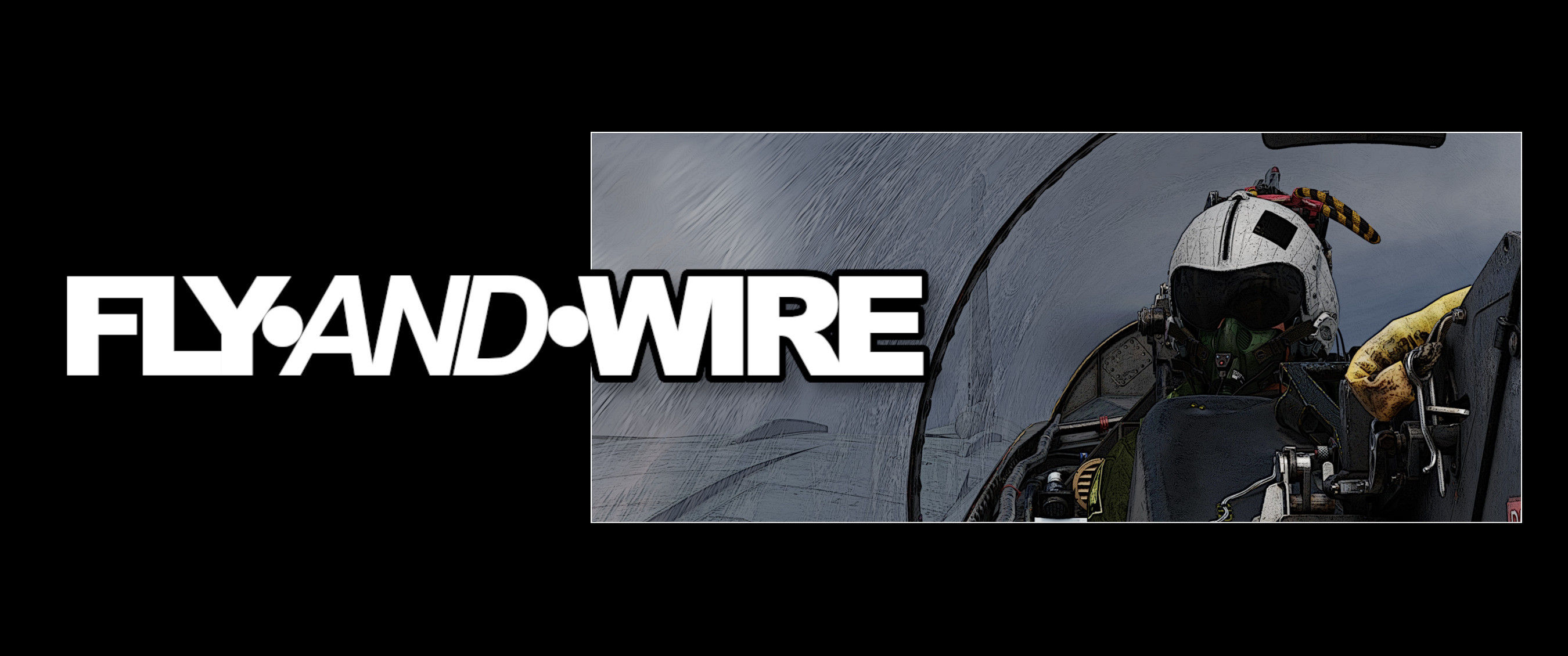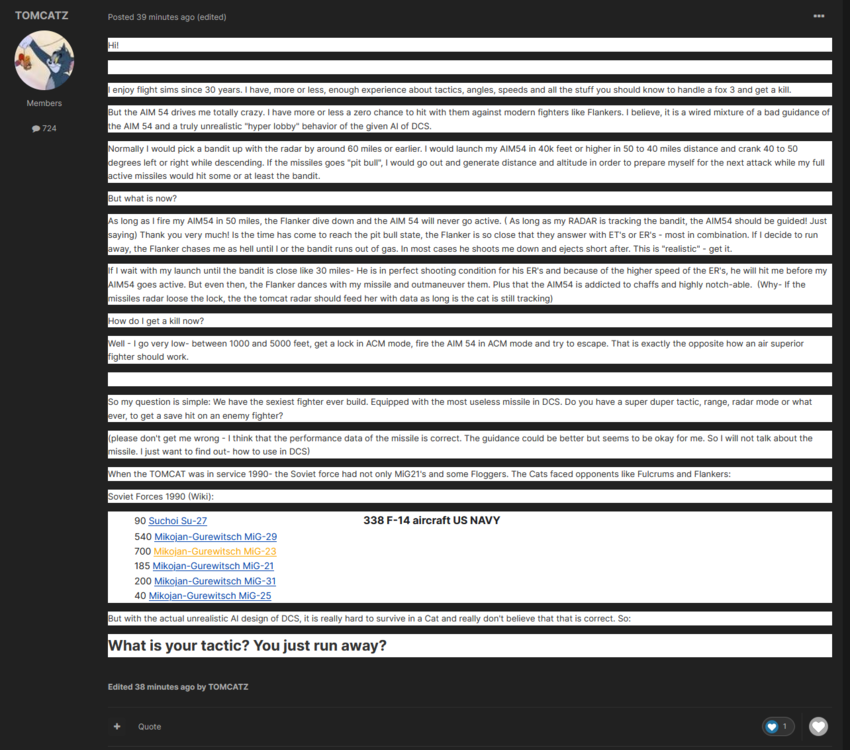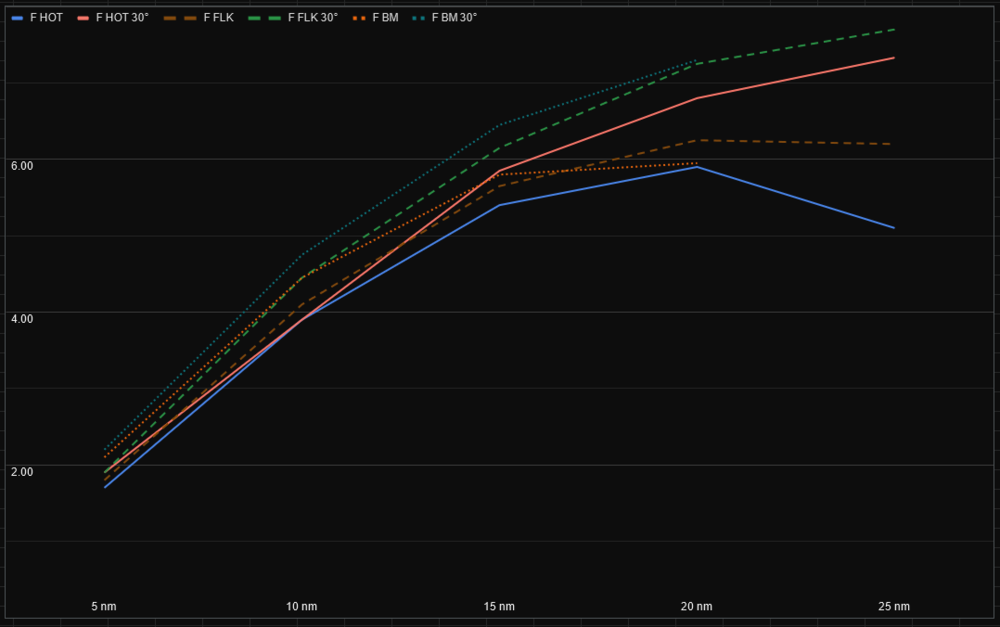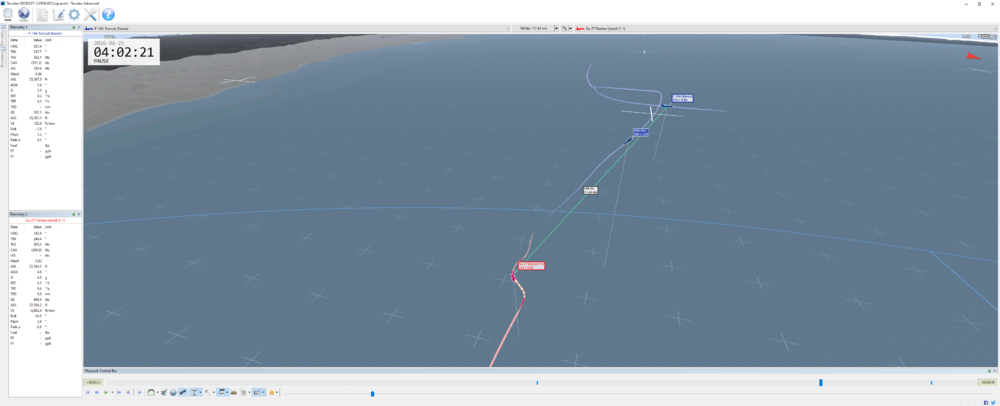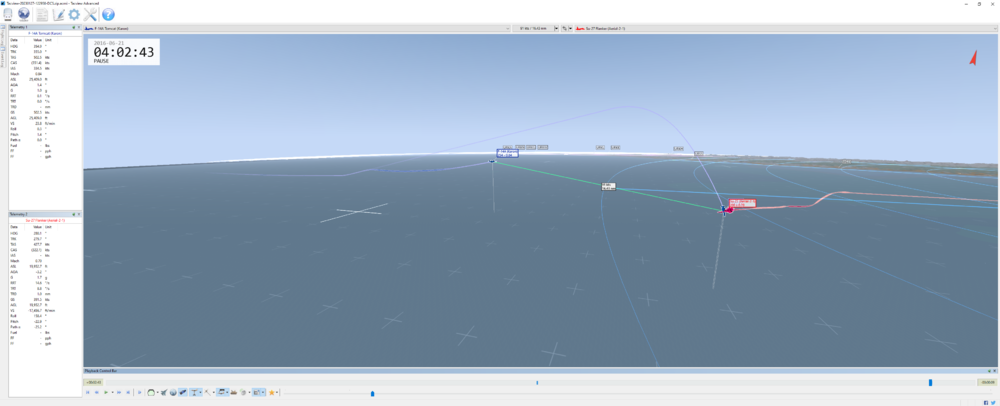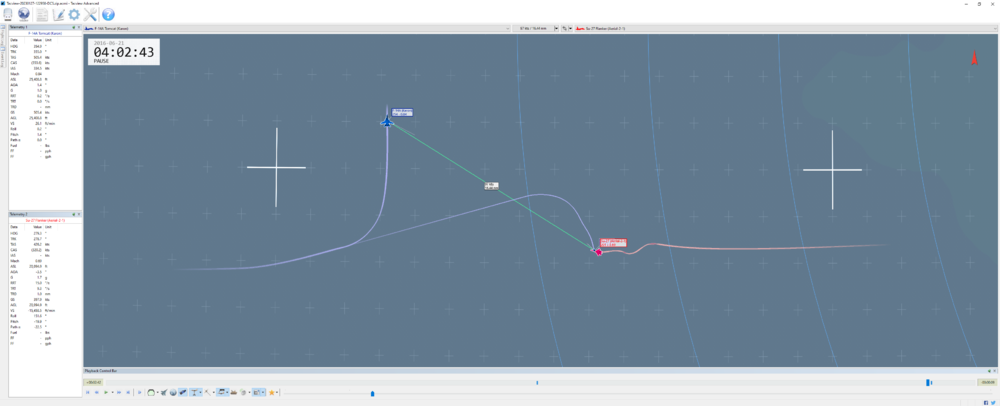-
Posts
1174 -
Joined
-
Last visited
-
Days Won
2
Content Type
Profiles
Forums
Events
Everything posted by Karon
-
Dogfight con il 104: 1 circle del diametro pari alla distanza tra Vigevano e Nuoro
-
Why? I love HB's manual, it has everything I needed to learn the aircraft, and I started from the basically zero in terms of modern fighter jets (I mean, I played LOMAC 20y ago…). The module is still in EA, parts are being polished or WIP, and thus subject to change. Perhaps the final update to the manual will arrive along the release.
-
Updated the first post, added a bunch of links. In the last few months, I worked on updating my DCS missiles database as I'm working on an updated timeline article. This is the last video posted today, which very rapidly shows, using a different approach, some of the most common missiles in DCS: Also, something different: Intercepts in a Hornet, using only the RWR (yep, it's a silly video)
-
If most do not go pitbull, there is something fundamentally wrong with the setup (e.g. your geometry, your modus operandi). The most common issue is the generation of an extrapolated track, which is more miss than hit. When this happens, the missile is not trashed, but the odds of being successful at timeout are often low. Preventing this is rather easy, go easy on the crank and keep an eye on the DDD for MLC and ZD zones. Your geometry should also take into account the situation post launch. Let's say you have a target on the nose at launch, TA 30R, direction (DoP) left to right, Cut 45; so basically drifting right (making numbers up, it may not be precise). In this situation, on a long-range shot, or if you crank L, you will make it notch you. This is why your RIO (or you) should keep an eye on the DDD, thus avoiding the generation of an extrapolated track and all the blablabla mentioned above. Feel free to share your Tacview track with us. Post scriptum: You may have missed this:
-
Nice! The first flight game I properly played for F-22 ADF in what, 1997? Then a bit of Falcon 4.0, then Il2, BS→ DCS. Np about the data, I had them around for a while, but I'm still in the process of giving them a greater sense of purpose. Problem is, it takes time. Enjoy Germany (feel free to share a Bratwurst )!
-
And that's precisely where I was going. You can't complain and rule out that you are doing something wrong if you do not use the tools that serve this purpose. Or, at least, provide the tracks to others, so they can help you. @TomcatFan1976 have a look here. This was a bit rushed, and it's very basic. It's much more complex than that, often, but at least there are some numbers inside:
-
Parlando con un ex pilota che l'ha provacchiato subito post release, il FM era proprio off. Post prime patch sembra meglio, ma diverge sempre piú quanto piú esci dal un inviluppo realistico. Per dire, nessuno si sognerebbe di fare un tonneau a 5m di quota IRL, ma con il primo FM c'erano condizioni nelle quali potevi volare sottosopra. Hanno pian piano aggiornato poi, tra il Kiowa, scissioni varie e problemi con un loro coder, hanno nettamente rallentato. Dovrebbe uscire, a un certo punto, un FM completamente fatto ex novo, o pesamente redatto. Come diceva lo Zulu qui sopra (lol) provalo. Finché non fai cose assurde, é divertente, e aggiunge una capacitá che manca in DCS attualmente.
- 261 replies
-
@TOMCATZ: before you start, keep in mind that I wrote the following rather quickly. Give me a shout if there's something not clear /**************************************************************************/ I thought I had more time, it turns out I didn't. @The_Tau has already lined up some facts, so I'm just going to add some numbers. Keep in mind the "age" thing. In primis, remember that the Tomcat is closer to a P-47 (32 years) than a JF-17 (33 years). This is a hyperbole, ofc, but it bluntly puts into perspective what we are dealing with. In secundis, you can read a lot of diverse and often wrong takes on the Phoenix on the internet. Trust the numbers, leave the rest out. PERFORMANCE Let's start with the performance. Ab initio players tend to miss the huge differences between common missiles and the Phoenix. This will probably happen again with the Meteor, at some point. The following is the impact speed of the C Mk47 vs range. Forget the loft for a minute, and look at the speed. Scenario: hot, Vc ~M1.9, 35,000ft. As you can see, it is not linear, and it is rather stable after a certain point. Let's use a different chart now. Same ordinate and abscissa, this time standard employment, no loft. They differ a bit because the criteria and the parameters of the scenario are different, primarily Vc (in this scenario the target is static): Due to the low Vc, this chart highlights better the performance of the missiles. See that big jump in the performance? This is due to how the Phoenix is controlled and commanded by the WCS. All this is explained in the manual, but it is paramount from the proper employment of the missile. Something these charts don't tell you, is how the vertical plane is used, so let's move to chart #3, which shows the Apex of the envelope. The employment altitude for this scenario was 35k. To no one's surprise, at 20 nm the altitude is 35k. Then, it increases almost linearly through the envelope. However, this affects the separation at timeout: The separation is again rather linear, and it settles at around 35%-40% of the initial separation. Problem: the chart above shows a manually lofted missile. Otherwise, the performance is worse. So, to put everything into context, we have a long stick, performance between 15-20 nm is poor, until ~30/35 nm is ok-ish, but very slow compared to others. Speaking of others, let's see how much modern missile compare to the AIM-54C Mk47 (1986). Here we have the AIM-120B (1994) and the R-27ER (1990, apparently?). The 120B is comparable-ish, it has advantages and disadvantages. At long range, the Phoenix prevails. The R-27ER is the fastest missile in DCS and blows even the AIM-120C-5 and the SD-10 out of the water. I wonder what they feed the missiles with in China, the SD-10 is damn fast! lol Important: I consider a cutoff date in my scenarios equal to mid 90s. Why? Because the geopolitical situation caused a lot of chances in the evolution of the Tomcat, the AIM-152 and so on, and we don't even have the F-14D. There is little point playing with an almost mid Cold War aircraft vs modern stuff. Therefore, I won't consider AIM-120C and SD-10. This is only a partial relief, as the R-27ER is still a huge threat (although notching in DCS is too easy. It shouldn't be like that). Comparing R-27ER and AIM-54C, we notice that, within a ~20nm, there is no story and the R-27ER performs better. The 120B is somewhat comparable depending on the range, and the Super 530D sits between the envelope of the 120B and the AIM-54. Also, this is a hot scenario, the moment the missile has to turn, farewell energy. So, in conclusion: let's take advantage of our strengths and employ at a range that allows us to safely shoot, and allows us enough room for second employment. 60 nm is a sweet spot, especially if you add a bit of loft. Considering cranking by definition (55ATA), A-Pole is around 25-30 nm. This should allow Out before MAR. Or, you can defend, assess and decide what to do next. The target has to defend the shot (btw, shooting to force someone to defend is nonsense, you shoot to kill), as at A-Pole its speed is M2+: Whatever you have decided, now we get to a shorter timeline, the important is employing in a situation where A-Pole > MAR. Although the 54C gives you a bit more room. The tricky bit here is making sure that you are launching at an advantageous range. If ~10/13nm < separation < 21 nm, then you are in for the worst performance possible of the missile. So, let's say we are down to 15k, MAR R-27ER should be ~17nm, if you shoot at 30+nm, the separation at A-Pole should be around 14/16 nm, which is dangerous but feasible (I'm eyeballing here). The last step depends on your plan. If banzai, notch for a few seconds (it's very easy in the Tomcat, especially with LINK4), if naked go in; otherwise I'd abort, bugout and wave goodbye. The Su-27 should not be able to catch you. You can almost always force a draw against any opponent. I tried to keep this is as simple and plain as possible. If you are new to this, and it sounds like plenty of random words, trust me, it's stupidly easy, and it's not as fancy as it sounds: - shoot at long range (60nm); - crank, manage speed to reduce Vc; - A-Pole, go out or prepare a follow-up shot; - second shot, monitor MAR, then merge or run away. Obviously, the problem with long-range shots, is that they are easily to defeat kinematically. A crank, sometimes, is more than enough. That's why the Phoenix is very strong in realistic, low SA scenarios. For example, in the Cold War, RWRs weren't as precise or common as today. In the Iran - Iraq war, but also in the 90s Gulf War, you see people dying whilst driving straight into a missile. In DCS, this does not happen at all! Humans know everything all the time as SA is too easy to obtain on any server, the avionics of many modules is better than an F-35, and the AI can notch perfectly even with the most basic RWR. These are some of the great issues of the Phoenix right now, but the biggest is the lack of understanding of the missile which, hopefully, it is now a bit more clear. RESOURCES Various definitions: https://flyandwire.com/2020/12/24/intercept-geometry-part-ii-definitions/ WEZ, MAR, LAR + Tool: the plan was to create a proper WEZ model for the 15 most common missiles in DCS, I don't have time to complete it right now, so this is more like a NEZ model. Get the missile performance tool linked inside: https://flyandwire.com/2023/02/17/determining-wez-mar-lar/ AIM-54 Manual loft - Part I: intro to the AIM-54. The Phoenix is unique, if you don't understand it, you're going to have problems. AIM-54 Manual loft - Part II: data discussion: kind of interesting if you want to squeeze a bit more energy out of the missile - at a cost. First look at the "new" AIM-54: written right after the patch. They should still work for a quick, non-in-depth overview. Energy: https://flyandwire.com/2022/09/05/new-aim-54-brief-look-part-ii-energy/ Guidance: https://flyandwire.com/2022/09/05/new-aim-54-brief-look-part-i-guidance/
- 39 replies
-
- 16
-

-

-
@TOMCATZI'm AFK ATM so I can't share charts and numbers with you. Therefore, I will reply better later. Quick observations: - Range Logic: I see your point of approximating altitude, range and performance. Unfortunately, it works for any missile besides the Phoenix! The AIM-54 is a unique missile in DCS, we'll see later why. - range vs manoeuvres: you are correct, the greater the separation at launch, the higher the possibilities that the target simply runs away. That's why it is a great missile for its era, where situational awareness was lower than nowadays and RWR were much less common and reliable (see the F1 in Iraq). However, that fact that the target manoeuvres does not mean that the missile is not activated, not at all! - Jester: the AI is great, but it is not as proactive as a human - I actually can't imagine people taking orders from an AI, so the Devs had to do it this way. However, I strongly recommend you to jump in the backseat post crank and monitor from there, switch to STT (turn the MLC off!) and so on. - Su & MiG: they are not particularly threatening if you respect the MAR. The R-27ER is bloody scary because it is fast, but again, respect the MAR and you are good. The R-77 came much later than the Tomcat, but it's a worse AIM-120B, thus manageble. I'll reply with more data later.
-
I'm skipping some of the other replies because I thoroughly disagree, but we are doomed to go OT otherwise. Back to your tracks, I could tell you to "do this or that", but I'd be rather pointless. It is better if you explain the modus operandi behind your engagements. So, why are you launching at the range you are launching? Why aren't you getting closer or, vice versa, farther? What are the parameters, characteristics or peculiarities, both of your aircraft and the target's that led you to that decision?
-
Trust me, I have tens of thousands hours in DCS if we count LOMAC as well. I used to spend whole weekends playing, and I still learn new things (and make mistakes) every day I'm looking forward to seeing your tracks, although I'm afraid that the verdict will be, at least partially, something along the lines of the AI doing AI things. That being said, I consider a PK of 40%-50% quite good in DCS. The Phoenix should be a bit lower than that.
-
null> a truly unrealistic "hyper lobby" behavior of the given AI of DCS. Yep, culprit #1. Don't play vs ACE AI. It's wasted time. > As long as my RADAR is tracking the bandit, the AIM54 should be guided! Just saying Neg. You said you are past A-Pole, in DCS the missiles are on their own. See below. > Is the time has come to reach the pit bull state, the Flanker is so close that they answer with ET's or ER's Review your timeline. You can spot a Flanker at 120+nm between AGC and PDSRCH, you have all the time in the world to employ multiple times. I agree on the ER though, I made a partial WEZ model, and it's crazy, it reminds me of the R-33 when ED forgot to implement something (the old R-33 was not losing any energy even when manoeuvring). I'm not saying it's wrong, but wow, that's a fast missile, much faster than the SD-10, which in turn is faster than the AIM-120C-5. > If I wait with my launch until the bandit is close like 30 miles- He is in perfect shooting condition for his ER's and because of the higher speed of the ER's At 30nm you still have the advantage (unless it's human, and it's lofting it): you don't have to babysit the AIM-54 until A-Pole, just let it go earlier. Also, no one says that you have to stay high post launch. The greatest jump in the MAR occurs between 35k and 25k. > the the tomcat radar should feed her with data as long is the cat is still tracking IRL only for the A, IIRC. Not implemented in DCS due to the game's limitations. > That is exactly the opposite how an air superior fighter should work. Why? At low altitude, the gap between the AIM-54 and the 27ER is at its narrowest point. To paraphrase a meme, you're flying in the whole sky, not only above 30k > Equipped with the most useless missile in DCS. Do you have a super duper tactic, range, radar mode or what ever, to get a save hit on an enemy fighter? Have you considered the possibility of user error? I have the feeling you do not properly understand the AIM-54, and especially what it needs to be successful. > When the TOMCAT was in service 1990- the Soviet force had not only MiG21's and some Floggers. The Cats faced opponents like Fulcrums and Flankers: You may have missed a *tiny* geopolitical fact that occurred in those years. Which led to a drastic change in, well, everything (ditching of the AIM-152 included). Not to mention that numbers on a piece of paper don't mean much, as we are all witnessing since last year, and looking at the past, the presence of working and up-to-date pieces of avionics in the Soviet inventory, such as modern RWRs, is debatable. Also, you listed 1755 aircraft. 5.1% are Flankers, definitely the most scary of the batch. So, I have the feeling you nailed the biggest issue: the AI. In DCS, it is uncapable of doing pretty much anything but notching or go cold (because it does know the energy status of the missile). When you see a MiG-21 perfectly notching your AIM-54 multiple times in a row, you ask yourself some questions, isn't it? My solution is making your missions more realistic by moving backwards a few years (although we'd need the 45/50 for that). Get rid of AWACS and datalinks, then randomise the opponent's skill up to veteran and their reaction type. For example, if you look at the Iran v Iraq war, or even the 90s Gulf War, you see aircraft blown out of the sky without even trying to defend. Lastly, what have you done to your post, my eyes are bleeding!
-
It sounds like a lot of work for little gain. For instance, every time you have a discrepancy between vC and vM, you may end up with Jester raising the issue. Problem is, it can happen quite frequently and often the problem is fixed from the front seat (AHRS). Jester doesn't have the capability of understanding when something is appropriate to the moment. The Devs can make it more aware in this sense, but it's a lot of work for something that is either very common (and you fix it yourself post CV departure, right?) or quite rare. Also, the WCS switches automatically to other modes if something critical fails (IIRC). At that point, the best course of action is probably RTB, and you can use NAVAIDS or the NS 430 for that purpose.
-
Not sure why you are quoting me, but yes, that is well known and one of the points I have been stressing for years: in DCS, you can fly a full intercept using only the RWR of an F/A-18. Ref the Iran v Iraq war, for example, according to Tom Cooper, the Mirage F1's RWR couldn't pick the AWG-9. Not good if you are an Iraqi pilot. Players can adjust their scenarios to simulate this and give more variety, but it requires manual labour. E.g. the campaign I made set in Iran '86 has a mix of randomised behaviour when engaged to mimic the issues of Iraqi avionics. The AI in DCS does not incorporate tactics vs active radar missile, on the contrary. It knows where the missile is at all time and, at 10nm, it defends. Defending from something that may have been launched involves more than a perfect notch at 10nm. Interestingly enough, the AI It defends in a similar way even when engaged in PDSTT. Unfortunately, this is the status quo, but I don't see how this is related to the AIM-54 Phoenix: every missile is affected, the Phoenix surely more, but it is not something HB can fix on their own. Thus, this is OT here. What we can do, whilst this gets fixed and improved by ED, is using workarounds as the one I mentioned before, and skipping Ace AI.
-
I may have linked the correct one, I picked the first one from Google, IIRC it had some comparisons and charts: if you manage to replicate those in a coherent, scalable system, you have the closest model we can get. That being said, only devs can give you the correct doc. EDIT: just to be extra clear, what I mean that, if NASA uses data for a test paper, those are good enough for a videogame imo.
-
HB has shown several times that they are willing to change things if they can be proven. So, do you have an actual study showing that the Phoenix can reach those numbers? If not, one of the better alternatives we have, as mentioned by @ValhallaAB and many others, is the study made by NASA that, although focused on a different goal, provides some details about the behaviour of the Phoenix. This is the study, straight from NASA itself: https://ntrs.nasa.gov/api/citations/20060004771/downloads/20060004771.pdf Do you have a better and reliable source? If not, there is nothing to fix (with some caveats, not strictly dependent on HB). Moreover, any car seller can say that their cars are the best in the world, it does not mean it is true. That's why devs need primarily numbers, not anecdotes. @Lurkergood points as usual, thanks mate!
-
No problem! It is actually an interesting point but, if I can be totally honest, the point you were making was not very clear. I understood it just because I worked on the separation at impact data recently. About why the USAF did not adopt it, I am not qualified enough to answer. Perhaps one cause is its initial task: taking down long-range threats, so Fleet defence. In fact, until mid/late 80s, the AIM-7 was the go-to weapon against fighters. Perhaps another cause is the fact that only two radars, as far as I know, guide it: the AWG-9 and its successor, the APG-71. The AIM-7 instead was employed by dozens of different aircraft and their radars: F-4, F-14, F-15, F-16, F/A-18; just to mention what is in DCS or coming soon™. Perhaps is just a matter of how different military branches operate. I pass the ball to others on this. Back to your original point, I exhumed a study I made about the AIM-7 a few months ago. Attached you find the separation at impact for the AIM-7F, launched at 25,000ft, M.9 vs hot, flanking targets, both standard employment and 30° loft. The second chart is the separation for the AIM-54C Mk47 launched at 35,000ft at M.9 for various level of manual loft. nullIn both cases, I did not crank. Unfortunately, the scenarios are not the same, but they give some ideas. Disregarding manual loft for the moment, you see that an AIM-54 launched at 60nm impacts when the Tomcat is at 25nm. This means that, even without cranking, going Out or doing anything post seeker activation, you are at the perfect range to prepare for an AIM-7 employment. So, imagine we want to hit a pack of bombers, and we have the usual 4/2/2 setup: we launch 4x AIM-54 TWS at 60nm, they are activated by the WCS and timeout when separation is 25nm. Now we can set up for the first AIM-7 at 25nm. It impacts at 7/8 nm, and we follow up with the second AIM-7. It impacts at 3/4 nm, now we can employ a front quarter AIM-9. As you can see, even without doing anything to reduce closure because perhaps we want to get close ASAP, before the merge we have launched 7 missiles, and we are left with one AIM-9, even if both the AIM-54 and the AIM-7 are quite slow missiles. I know this example is very simplistic and quite idiotic, but please let me know if it makes sense to you. Also, remember that the AWG-9 is stuff from the 60s: technology, doctrine, tactics, threats changed a lot since then. However, if you take this in the context of the era, with the F-14s located 100+ nm from the carrier between the threat and the CV group, I don't see the speed of the AIM-54 as a big deal, tbh.
-
What did you do post launch? Cranked? Reduced speed? Went Out at activation? There are several means to increase separation whilst the missile is flying, and you can push the performance of the missile even more, if needed. I see what you mean with Creech, but 7 nm Vs a striker can still be relevant. Also, let's say their objective is close to the border or a SAM site: you can throw a missile that intercepts them as they are crossing or out of the SAM envelope, but if you have to sustain a Sparrow, this may not be feasible. I don't know if you see where I'm going. Then we can talk geometry: your example may partially prove a point in a hot scenario, but if the intercept is colder and you need to stop the target, only the Phoenix will get to the target (have a look at WEZ and LAR). As you can see, the matter is much more complex than you put it. Also, yep, the AIM-120 is a much modern missile. But, you know, to name the two we have in-game, the AIM-120B was introduced 20 years after the 54A, the C-5 was introduced 26 years later. I understand was Mr Einstein said, but time, experience, technological advancements, can't really be bent as we can do in a videogame. But I'm sure the Brits during the Battle of Britain wouldn't have minded a good stock of Meteor missiles. They would have closed the matter much sooner EDIT: actually, this is an interesting topic, especially when it comes to the geometrical aspect. I'll put something together next week, if I have time.
-
@draconus It wasn't meant to be funny, I'm the most serious person ever. Check the attached screenshots and tracks. I let Iceman do the easy turn North, but I could have made a split-s myself, as the missile didn't need any support. Unfortunately, this is PSTT until a new system (the new API, I guess) is implemented on ED's side. Tacview-20230127-122958-DCS.zip.acmi
-

Feedback Thread F-14 Tomcat - Update 24th Jan. 2023
Karon replied to IronMike's topic in DCS: F-14A & B
This is the discussion about the Phoenix, feel free to share your tacview tracks and recordings.

